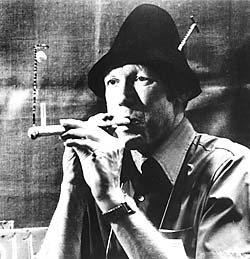Whimmydiddles and FlipperDingers
A Visit with Toymaker Dick Schnacke
By Catherine Moore

Dick Schnacke demonstrates the challenging FlipperDinger at the Mountain State Art & Craft Fair near Ripley in about 1975. He is wearing a Whimmydiddle tucked into his hat. Photographer unknown.
As we bounce down a wrinkled, one-lane road in northern Wetzel County, Dick Schnacke is reminded of one of the many eccentric ideas he has had over the years to create fun in day-to-day life. "You know those bumps on the side of the road?” he says. “Rumble strips, I think they're called. Well, I've always thought it would be great if you could make them play a song. They could play ‘The West Virginia Hills!’"
As he enters the Mountain Craft Shop, Schnacke, a tall slender man of 85 with bright blue eyes, breathes deeply and says, "It's like a little piece of heaven. Just like it used to be, but better. It's so familiar to me." Dick built this business more than 40 years ago. At one time, he employed 15 people and produced upwards of 45,000 toys a year.
Dick and the new owners of the Mountain Craft Shop, Ellie and Steve Conlon, demonstrate their wares, which include puzzles, games, tricks, dolls, noisemakers, finger puppets, flying toys, shooting toys, animated toys, and others that don't seem to fit comfortably in any category.
One of the first toys Schnacke started producing was the Whimmydiddle (also known as the Hooey Stick or Gee-Haw) – a hardwood twig with notches carved into the wood near the end. On the tip, there is a smaller, propeller-like stick mounted with a nail. When you run a piece of wood over the notches, the propeller gets going and spins, as if by magic. Rub it a different way, and the propeller reverses. One branch can yield multiple Whimmydiddles, if you want to try a double- or triple-ended variation. Legend says that the Whimmydiddle is also a lie-detector.
Then there's the FlipperDinger, another Mountain Craft classic. This toy consists of a hollow wooden pipe through which you blow air, in a maddening effort to hook a very light corn-pith ball to a wire hoop mounted above the end. Experts like Schnacke can perform the trick without too much effort, but those unacquainted will be surprised at how challenging it can be. Unhooking the little ball is even more difficult.
There's also the Do-Nothing Machine, which, unless you know something about physics, seems to do just what it says quite effectively. One day at a craft fair in Ripley, though, two scientists from West Virginia University spied the toy and Schnacke overheard them compare the toy to elliptical trammels and mention that they might be able to make an engine out of the design. A year or so later, Schnacke heard that they actually had built the four-cylinder engine, put it in a car, and initiated road tests.
Even the names of the toys are beautifully crafted: Mountain Bolo, Musical Marble Tree, Exploding Outhouse, Moon Winder, Skyhook, Hoop Snake, and Limber Jack. This is the poetry of folk toys.
The son of a civil engineer who designed railroad bridges, Dick Schnacke grew up in Topeka, Kansas, during the Great Depression. He made folk toys to amuse himself, though the clever creations weren't known by that name at the time. Making toys wasn't about American heritage or tradition, it was just a way to have fun, Dick tells me. It never entered the young boy's mind that he would one day turn the frivolous gizmos into his life's work.
You can read the rest of this article in this issue of Goldenseal, available in bookstores, libraries or direct from Goldenseal.